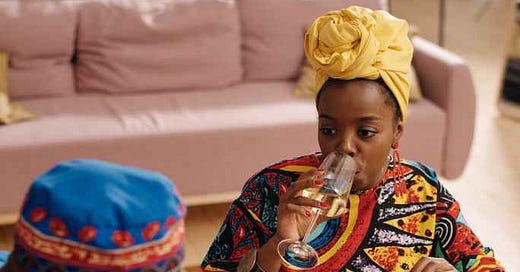This article on Umoja is part of the 2023 series we wrote on combining Christmas and Kwanzaa traditions. We'd love to hear your thoughts!
The Misogynoir to Mishpat (M2M) Research Network © 2024
The holiday season is a wonderful opportunity to explore the unifying principles of Kwanzaa and Christmas. Such an exploration has the potential to cultivate social cohesion beyond the superficial differences of these two holiday rituals.
Umoja means unity in Kiswahili, the foundational Kwanzaa value. Its ethos underscores shared heritage within families, neighborhoods, the African diaspora, and global community. This serves as timely reminder that proactive solidarity empowers while insular tribalism diminishes.
Crossing Boundaries
Biblical texts also elevate unity. Though often overlooked, Jesus’ public ministry displayed radical hospitality defying religious, socioeconomic, ethnic and gender barriers prevalent in that period. Rather than staying place, Jesus crossed boundaries such as going to Canaan where he was prompted by the Canaanite woman to use his gifts to benefit people other than the Children of Israel (Mat. 15:21-28). Though he said “I was sent only to the lost sheep of Israel (v. 24), she convinced him to expand this vision of his ministry (vv. 25-28). Here, the vision primordially elevates multiethnic kinship over social conformity.

In the Old Testament, Ruth the Moabite also exhibits unity across cultural differences. As an impoverished foreign widow, her unifying virtues are demonstrated in her persevering loyalty to and solidarity with her marginalized Israelite mother-in-law Naomi. This filial piety spanned vulnerability lines of nationality and grief. Upon returning to Judah, Ruth creatively invested tireless labor as subsistence gleaner while experiencing ethnic othering.
Crossing Economic Boundaries
Still, Naomi’s relative, Boaz, made space for Ruth within the harvester community. Ruth’s small acts of love mended human divisions ― generativity honoring Umoja’s emphasis on shared heritage across constructs like ethnicity and class. Her great-grandson King David descended from mixed Moabite-Judahite lineage, foregrounding Jesus’ gospel of social inclusion rather than exclusion.
For contemporary society fractured along countless divides, Ruth and Naomi’s story proves ever relevant. Presently, many Black women and those from ethnic/racial minority groups relate to feeling vulnerable due to pervasive systems of alterity categorization. Like Ruth, they unequally bear the intersecting impacts of prejudice based on gender, class, ethnicity, language, nationality and other identity markers which procure estranging “outsider” status.
Resisting Tribalism
Despite the tribalism plaguing so much public discourse and policy-making worldwide, internalizing stories like Ruth’s are useful for engendering humanizing postures of empathy, courage and solidarity across constructed social boundaries. Interrogating root inequities are vital to ensure our communities need not constantly transcend normal human limits simply to survive.
Kwanzaa’s unity principle provides concrete, unifying actions within contemporary holiday practices. Education about winter holiday traditions from various cultures can inform intercommunal hospitality initiatives. For example, shared services and cross-cultural worship can jointly celebrate distinct December holy days oriented around shared visions of peace and justice.
Protecting the Vulnerable
Additionally, Boaz models a social identity construct that critiques the tendency to “other” the minorities within his midst as he instructs his workers not to even scold Ruth if she transgress certain boundaries.

8 So Boaz said to Ruth, “My daughter, listen to me. Don’t go and glean in another field and don’t go away from here. Stay here with the women who work for me. 9 Watch the field where the men are harvesting, and follow along after the women. I have told the men not to lay a hand on you. And whenever you are thirsty, go and get a drink from the water jars the men have filled (Ruth 2:8-9).
While Ruth presents as an impoverished woman, Boaz took in the whole measure of this woman. She was not just someone in need, she was someone of compassion. Boaz, a man of authority, decided to ensure she was protected and treated with respect. Despite our many efforts to help the “less fortunate,” we often lack the capacity to help the homeless and hungry among us. Instead of reducing people to being no more than the sum of their worst experiences, we can seek to understand the “whole measure” of who they are.
Conclusion
Doing this provides us with opportunities to create unity within our communities and beyond. Those facing regular marginalization due to ethnic/racial, gender or socioeconomic vulnerability markers may continue creatively investing in an unrealized yet more just social order through perseverant acts of solidarity and not self-protective withdrawal. In these ways, communities better actualize beloved reconciliation envisioned by prophets and principles undergirding vital cultural celebrations such as Kwanzaa and Christmas.
Dr. CL Nash for The Misogynoir to Mishpat (M2M) Research Network © 2024
Further Reading (Kwanzaa, Theology and Religion)
For further reading to explore Kwanzaa, African spirituality, themes within the book of Ruth and exploration into radical hospitality, please see the following resources.
Karenga, M. (2018). Kwanzaa: A celebration of family, community and culture. University of Sankore Press.
Paris, P.J. (1995). The spirituality of African peoples: The search for a common moral discourse. Fortress Press.
Hicks, H. (2003). Critical analysis of the book of Ruth as a model for African American women’s experience. Journal of Feminist Studies in Religion, 19(1), 35-50.
Perkins, P. (2009). Welcoming the stranger: A public theology of worship and evangelism. Abingdon Press.
Volf, M. (2019). For the life of the world: Theology that makes a difference. Brazos Press.




